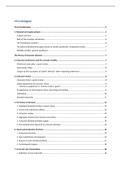Resume
Samenvatting Micro-economie
Mijn samenvatting is de beste up to date versie van het Micro-economie vak dat in het tweede jaar wordt gegeven voor de gehele FBE studenten. Hier wordt alles in vermeld dat je moet kennen en kernachtig samengevat. De kern en de nodige grafieken staan er in. Als je dit leert, ken je de gehele theor...
[Montrer plus]




